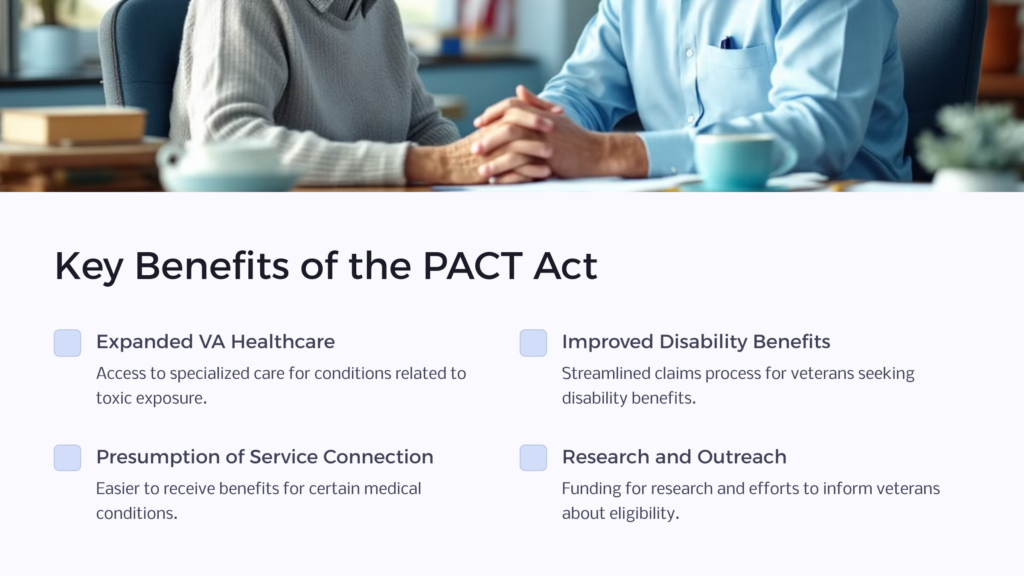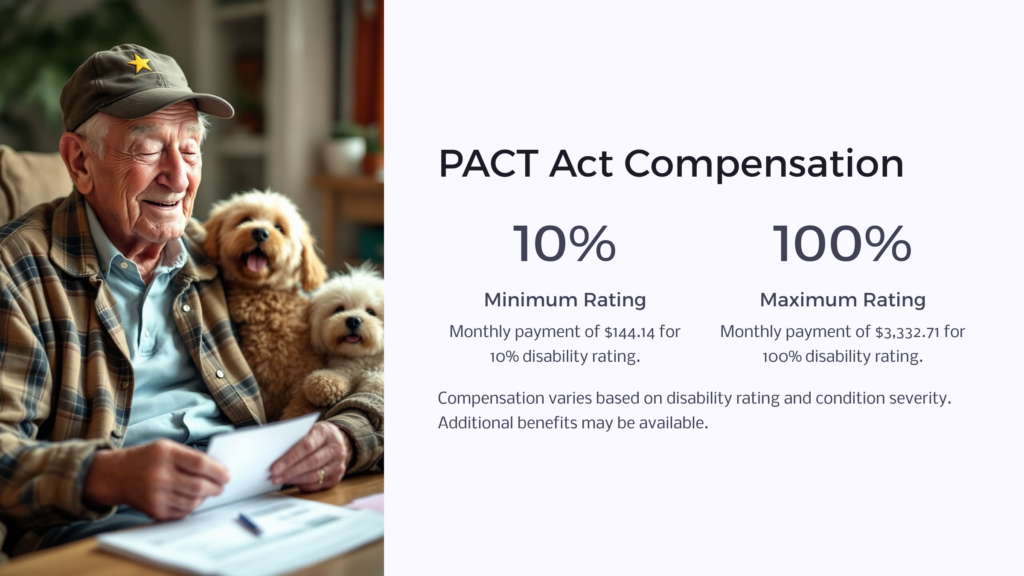What are the PACT Act benefits?

For decades, many veterans who were exposed to toxic substances during their service have struggled to receive the medical care and benefits they deserve. However, a new law called the PACT Act (Proven Agent Orange Compensation for Veterans Today Act) aims to change that by expanding VA healthcare and benefits for veterans exposed to burn pits, Agent Orange, and other harmful substances.
Thanks to this act, there is a range of benefits available for veterans who have been exposed to toxic substances during their service. Let’s talk about some of the key aspects of these benefits!
Expanded VA Healthcare
The PACT Act expands VA healthcare to veterans who were exposed to burn pits, Agent Orange, and other toxic substances. This includes access to specialized medical care and treatment for conditions related to toxic exposure.
Improved Disability Benefits
The PACT Act provides disability benefits to veterans who have been diagnosed with a medical condition related to toxic exposure. The law also streamlines the claims process for veterans seeking disability benefits.
Presumption of Service Connection
The PACT Act establishes a presumption of service connection for certain medical conditions related to toxic exposure. This means that veterans with these conditions are presumed to have been exposed to toxins during their service, making it easier for them to receive VA benefits.
Research and Outreach
The PACT Act provides funding for research into the health effects of toxic exposure and for outreach efforts to help veterans understand their eligibility for VA benefits.
Diseases Associated with Agent Orange
The PACT Act includes several diseases that are associated with exposure to Agent Orange, a herbicide used during the Vietnam War. These diseases include:
- AL Amyloidosis
- Chronic B-cell Leukemias
- Chloracne or similar acneform disease
- Diabetes Mellitus Type 2
- Hodgkin’s Disease
- Ischemic Heart Disease
- Multiple Myeloma
- Non-Hodgkin’s Lymphoma
- Parkinson’s Disease
- Peripheral Neuropathy, Early-Onset
- Porphyria Cutanea Tarda
- Prostate Cancer
- Respiratory Cancers (including lung cancer)
- Soft Tissue Sarcomas (other than osteosarcoma, chondrosarcoma, Kaposi’s sarcoma, or mesothelioma)
- Amyotrophic Lateral Sclerosis (ALS)
- B-cell leukemias
- Bone Cancer
- Non-Melanoma Skin Cancer
- Renal Cancer
- Testicular Cancer
- Leukemia
- Larynx Cancer
- Aplastic Anemia
Respiratory Illnesses Associated with Burn Pit Exposure
The PACT Act includes respiratory illnesses such as chronic bronchitis, asthma, and emphysema associated with exposure to burn pits, which were used to dispose of waste materials at military bases in Iraq and Afghanistan.
Gulf War Illness
The PACT Act also benefits veterans with Gulf War Illness, a condition characterized by symptoms such as fatigue, joint pain, and gastrointestinal problems. This condition is associated with the service in the Gulf War during the early 1990s.
Toxic Exposure to Other Chemicals
The PACT Act also acknowledges the harmful effects of exposure to other chemicals, such as lead and asbestos, which have been linked to various medical conditions, such as mesothelioma and chronic obstructive pulmonary disease (COPD).
How Much Will the PACT Act Pay?

The compensation paid to veterans under the PACT Act varies depending on several factors, including the severity of the condition and the veteran’s disability rating.
Under the PACT Act, veterans with a service-connected disability rating of at least 10% for one or more of the 23 presumptive conditions are eligible for compensation. The compensation paid to the veteran is determined by their disability rating, which ranges from 0% to 100%. The higher the disability rating, the more compensation the veteran will receive.
For example, a veteran with a 10% disability rating for a presumptive condition may be eligible for a monthly compensation payment of $144.14. In comparison, a veteran with a 100% disability rating may be eligible for a monthly payment of $3,332.71. These amounts are current as of 2021 and are subject to change based on yearly cost-of-living adjustments.
It is important to note that veterans with multiple service-connected disabilities may receive additional compensation for each disability. In addition to compensation payments, eligible veterans may receive health care benefits and other assistance through the Department of Veterans Affairs.
It is also worth noting that veterans receiving benefits under the PACT Act may be eligible for other forms of financial assistance, such as Social Security Disability Insurance (SSDI) or Supplemental Security Income (SSI). However, eligibility for these programs is determined by different criteria and is not directly related to the PACT Act.
How Much Financial Compensation Can You Receive for Pit Burn Exposure?
The financial compensation for veterans exposed to burn pits is determined case-by-case. It depends on various factors, including the severity of the veteran’s health condition, the degree of disability, and the length and location of their exposure to burn pits.
Under the PACT Act, veterans who have been exposed to burn pits and have developed a related illness or health condition may be eligible for disability compensation from the Department of Veterans Affairs (VA). The amount of compensation paid to the veteran is based on their disability rating, which ranges from 0% to 100%. The higher the disability rating, the more compensation the veteran will receive.
For example, a veteran with a 10% disability rating for burn pit exposure may be eligible for a monthly compensation payment of $144.14. In comparison, a veteran with a 100% disability rating may be eligible for a monthly payment of $3,332.71. However, it is important to note that these amounts are subject to change based on yearly cost-of-living adjustments.
In addition to compensation payments, eligible veterans may also receive health care benefits and other forms of assistance through the VA. These benefits can help cover the cost of medical treatment, medications, and other related expenses.
It is important to note that compensation for burn pit exposure is not guaranteed, and veterans must provide evidence linking their health condition to their exposure to burn pits. This can be a complex process, and veterans may need to work with a VA-accredited representative or attorney to build their case and navigate the claims process.
If you believe you may be eligible for compensation for burn pit exposure, it is recommended that you contact the VA to learn more about your options and how to apply for benefits. The VA has resources available to help veterans understand their rights and navigate the claims process, including the VA’s Burn Pit Registry and the Airborne Hazards and Open Burn Pit Center of Excellence.
Can All American Veterans Access PACT Benefits?
No. PACT benefits are specifically designed to provide compensation and health care to eligible veterans who have been exposed to toxic substances during their service, including Agent Orange and burn pits.
To be eligible for PACT benefits, veterans must have served in the military during a period of conflict or war and have been exposed to one or more of the 23 presumptive conditions related to toxic exposure. These conditions include Parkinson’s disease, ischemic heart disease, and various cancers.
Additionally, veterans must have received an honorable or general discharge to be eligible for PACT benefits. Other factors that may affect eligibility include the duration of the veteran’s service and the location of their service.
It is important to note that eligibility for PACT benefits can vary depending on the specific circumstances of each veteran’s service and exposure. Therefore, it is recommended that veterans contact the Department of Veterans Affairs to learn more about their eligibility and how to apply for benefits.
In addition to PACT benefits, American veterans may be eligible for other forms of assistance and support, including disability compensation, education and training benefits, home loan assistance, and medical care through the VA healthcare system. The specific benefits available to veterans depend on their individual circumstances and service history.
How do I Know If I Qualify for PACT Benefits?
You must meet certain eligibility requirements to determine whether you qualify for PACT benefits.
First, you must be a veteran who served in the U.S. military during a period of conflict or war and was exposed to one or more of the 23 presumptive conditions related to toxic exposure. These conditions include Parkinson’s disease, ischemic heart disease, and various cancers.
Next, you must have received an honorable or general discharge to be eligible for PACT benefits. Other factors that may affect eligibility include the duration of your service and the location of your service.
To apply for PACT benefits, you must complete an application form and provide supporting documentation, such as medical and service records. The Department of Veterans Affairs (VA) will review your application and determine whether you meet the eligibility requirements for PACT benefits.
You can contact the VA for assistance if you are unsure whether you qualify for PACT benefits. The VA has resources available to help veterans understand their rights and navigate the claims process, including the VA’s Burn Pit Registry and the Airborne Hazards and Open Burn Pit Center of Excellence.
Additionally, you can work with a VA-accredited representative or attorney who can assist you in building your case and navigating the claims process. These individuals have experience working with the VA and can help you understand your eligibility and the steps necessary to apply for benefits.
Determining your eligibility for PACT benefits can be a complex process that depends on various factors. Therefore, it is recommended that you contact the VA or a VA-accredited representative for assistance in understanding your eligibility and how to apply for benefits.
Does the PACT Act Replace Social Security?
No. It expands healthcare and benefits for veterans who were exposed to toxic substances during their service, including Agent Orange and burn pits. It provides compensation and healthcare benefits specifically to eligible veterans who were exposed to toxic substances and have developed one or more of the 23 presumptive conditions related to toxic exposure.
Social Security, on the other hand, is a federal program that provides retirement, disability, and survivor benefits to eligible individuals. Social Security is available to all American citizens who have paid into the program through payroll taxes. The benefits are not tied to military service or exposure to toxic substances.
While both programs provide financial benefits to eligible individuals, they serve different purposes and have different eligibility requirements. For example, eligibility for Social Security benefits is based on factors such as age, work history, and disability status. In contrast, eligibility for PACT benefits is based on military service and exposure to toxic substances.
Can I Receive PACT Benefits While Working?
You can receive PACT benefits while working. There is no specific work or income restriction for PACT benefits as long as you meet the eligibility criteria.
PACT benefits are available to eligible veterans who were exposed to toxic substances during their service, including Agent Orange and burn pits, and have developed one or more of the 23 presumptive conditions related to toxic exposure. These benefits include compensation, healthcare, and other support services.
The amount of compensation you receive will depend on various factors, such as the severity of your condition, the duration of your service, and your disability rating. However, receiving PACT benefits does not prohibit you from working or earning income from other sources.
It is important to note that if you currently receive other types of disability benefits, such as Social Security disability benefits, there may be restrictions on how much you can earn from work while still receiving benefits. However, PACT benefits do not have such restrictions.
How do I Apply for PACT Benefits?

To apply for PACT benefits, you will need to follow the application process outlined by the Department of Veterans Affairs (VA). Here are the general steps for applying for PACT benefits:
Gather the Necessary Documents
To apply for PACT benefits, you must provide documentation of your military service, exposure to toxic substances, and medical diagnosis. This may include your military service records, medical records, and any other relevant documents.
Complete and Submit the Application
You can apply for PACT benefits online through the VA website or by completing a paper application and submitting it to your local VA office. The application will ask for information about your military service, exposure to toxic substances, and medical condition. You will also need to provide supporting documentation.
Await a Decision
After you submit your application, the VA will review your eligibility and medical evidence to determine if you are entitled to PACT benefits. This process can take several months, so patience is important.
Appeal if Necessary
If your application is denied, you have the right to appeal the decision. The appeals process can be complex, so it is recommended that you work with a VSO or an attorney who is experienced in handling VA appeals.
 Benefits.com Advisors
Benefits.com Advisors
With expertise spanning local, state, and federal benefit programs, our team is dedicated to guiding individuals towards the perfect program tailored to their unique circumstances.
Rise to the top with Peak Benefits!
Join our Peak Benefits Newsletter for the latest news, resources, and offers on all things government benefits.





















